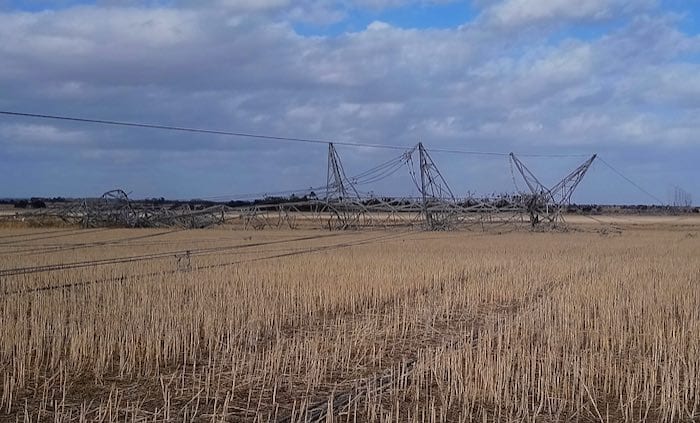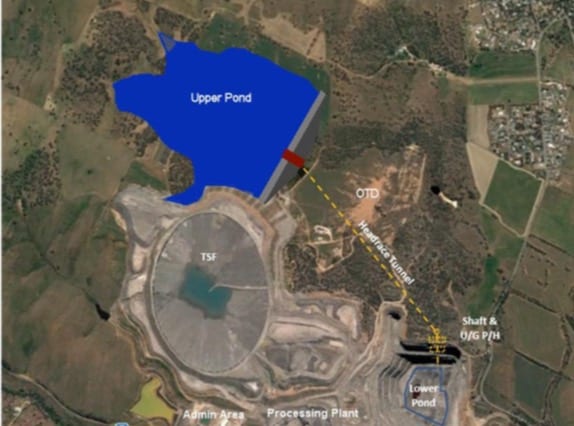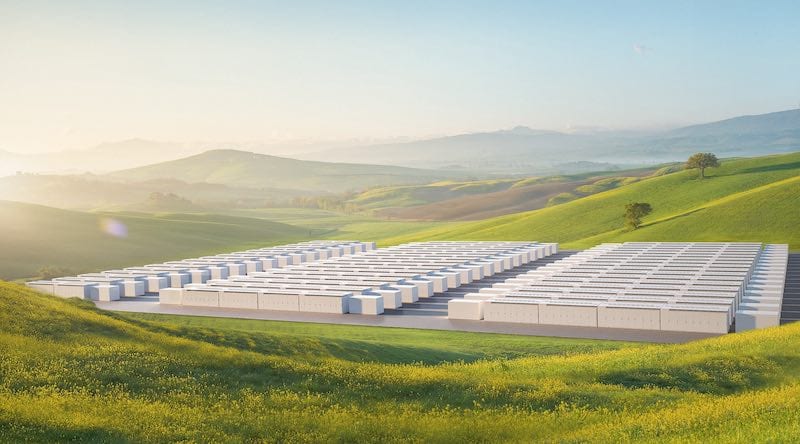Wind and batteries saved the day when storm cut South Australia adrift
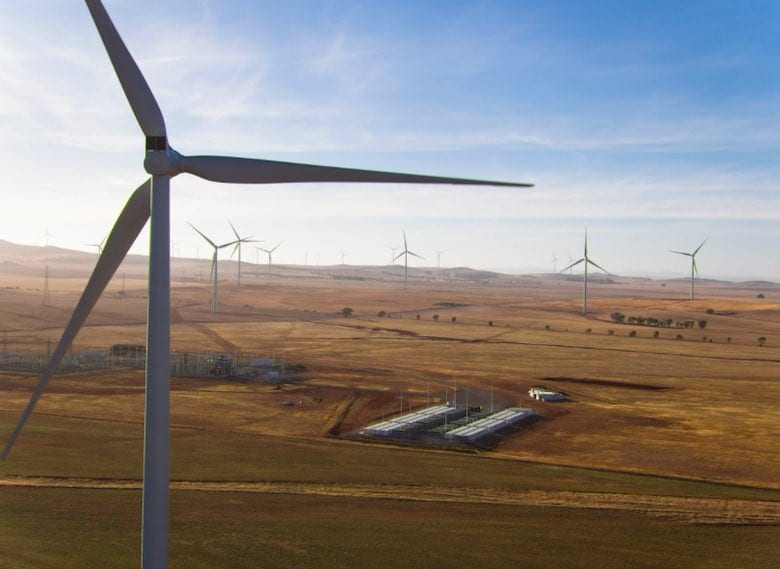
South Australia’s wind farms and its growing fleet of big batteries played a critical role in keeping the lights on in the state after the dramatic weather events that resulted in one of the country’s biggest transmission lines being torn down by storms.
The events on the afternoon of Friday January 31 saw the South Australia grid separate from the rest of the National Electricity Market, and it has been operating as an effective island ever since – a ground breaking achievement given the level of renewables in the local grid and the added complexity of having to host the huge Portland aluminium smelter, which also found itself cut off from the rest of Victoria’s grid.
But it is the critical role played by South Australia wind farms and its three big batteries (Hornsdale, Lake Bonney and Dalrymple North) that point to the added grid security that comes with inverter-based technologies such as wind, solar and batteries, and their accompanying software.
When the storms hit on the afternoon of January 31 and tore down the massive 500kV transmission line (much bigger than the 275kV lines hit by tornadoes before the South Australia system black in 2016), South Australia had been exporting about 460MW of capacity to Victoria.
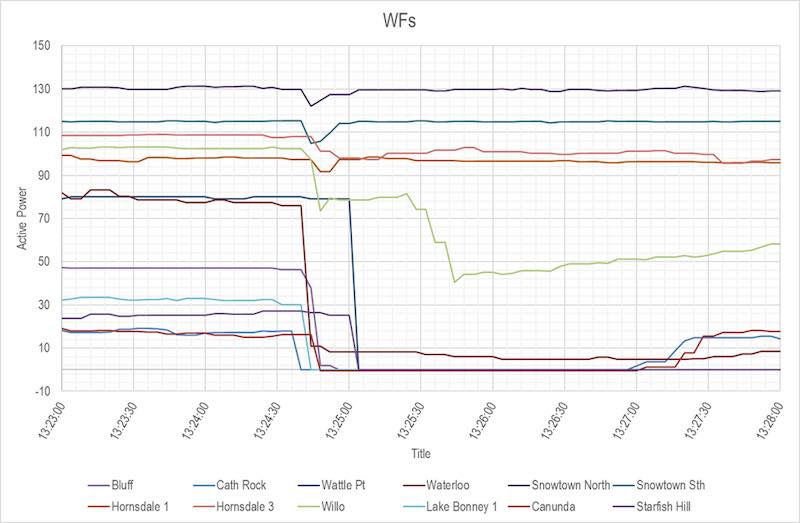
The loss of the link meant that South Australia had way too much generation and the event pushed frequency levels up dangerously high. But several wind farms responded – as they are now programmed to do – by immediately reducing their output.
(This is called over frequency generator shedding, see graph above).
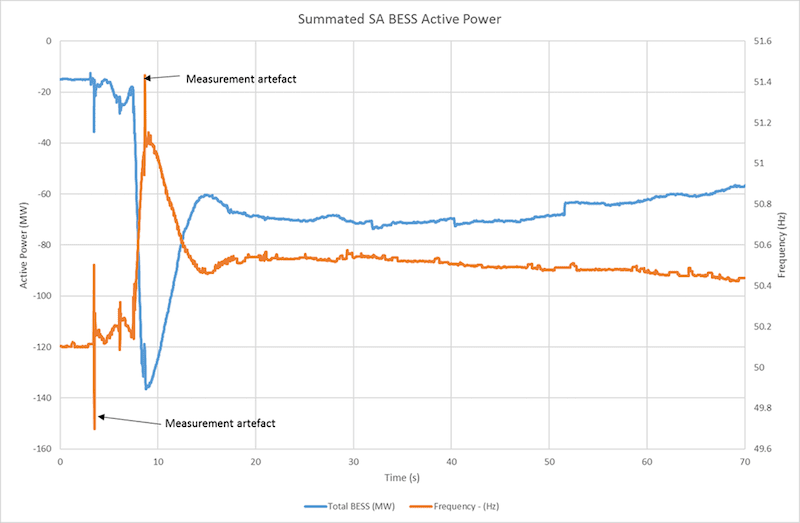
And the batteries helped by immediately ramping up to charge and therefore add load to the grid – and then quickly change direction again as the frequency fluttered. (The three batteries are represented in blue in graph above. Orange is the frequency).
Some gas generators also responded, but the bulk of the instant response came from the wind farms, the three big batteries and two of the bigger solar farms. Rooftop solar also played a role, with inverters switching off – as they are now expected to do in such situations – adding to system demand, which is what the market operator wanted at the time. (See graph below).
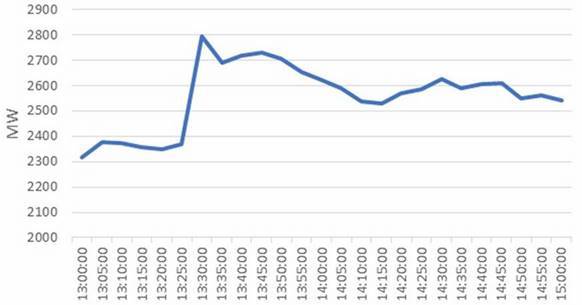
Indeed, it was the speed and the accuracy of the inverter-based technologies that AEMO engineers say was the key to bringing the frequency excursion back under control, keeping the lights on and preventing the type of catastrophic result that occurred in the “system black” in September 2016.
More details and insight are expected to be released when AEMO publishes its full report into the separation event in coming weeks.
There is no way of knowing what would have happened on January 31 had there been no wind generation in South Australia, or big batteries, and the operator had to rely only on a quick response from thermal generation (coal or gas).
That might be a moot point, anyway, because gas generation is usually so expensive it is unlikely it would have found a place in the Victoria market, so South Australia would be unlikely to have been exporting as much, if at all.
What the event of January 31, and the performance of the South Australia grid since that time, will do is help dismiss some of the myth-making about “variable” renewables such as wind and solar, and the benefits of battery storage.
What happened to South Australia is about as bad as it gets, but without coal, and without hydro, it has been managed in exemplary fashion. And it should be a tribute to good engineering, and an endorsement of renewable and battery technologies, and of the Liberal state government’s goal of reaching “net 100 per cent” renewables by 2030.
Since January 31, the South Australia grid has been operating as an effective “island”, with the added complexity of having the huge Portland aluminium smelter hanging off the end of the line, even though it is located in Victoria (but on the South Australia side of the stricken transmission line).
AEMO had never modelled such an outcome, and engineers who quickly put together a new set of scenarios compare the situation with having a “scooter towing a trailer”, with 500MW of constant load hitched to the end of a grid which often caters for less than 800MW scattered across an entire state.
It is seen as something of a world first, not least because South Australia has continued to operate with an average of more than 50 per cent renewables for the two weeks it has been operating as an island, and it has done so with a lower cost of power than coal-dominated NSW.
Fortunately, the Mortlake gas generators were also located on the South Australia side of the network break, because without them the smelter would have had no power and would have closed: the way the S.A. grid is designed, thermal or no thermal, it simply couldn’t supply such a power-hungry consumer at the end of a skinny line.
For the last two weeks, AEMO has had to redesign its market parameters. The three big batteries were taken out of the day-to-day market and put on standby – held at a constant state of charge at a “midpoint” because AEMO sees them as the best tool in its tool box to deliver fast and versatile response in case of any sudden trips in load or supply.
It’s not the first time that the batteries have played a critical role in keeping the lights on. Hornsdale was quick to show off its wares soon after its connection in late 2017 by responding quickest to one of the many coal unit trips in Victoria, and it was key to stabilising South Australia when another major transmission problem (this time from lightning) cause the separation of both Queensland and South Australia in August, 2018.
It’s also a testament to the qualities of wind power. The settings on the software of various wind farms was partly blamed for the 2016 system black. Part of the problem was that the settings were not known. AEMO has since made sure that software does what it is supposed to. This is a clear validation of the technology.
Since January 31, some wind farms have been sidelined – Macarthur in Victoria because it had no more link to the grid, and Portland in Victoria because it injects power into the Portland sub station and that was deemed to hard to manage, along with 275MW Lake Bonney wind farm and the Canunda wind farms which found themselves at the end of the line and without enough system strength to operate.
The amount of gas generation running at any one time was also lifted, to ensure enough synchronous capacity in the absence of the link to NSW. Such measures would probably not be required once new synchronous condensers are installed over the coming 12 months, and a new link to NSW built by 2024.
Still, the South Australia grid has continued to operate with wind and solar providing an average of more than 50 per cent of local demand, some times up to 75 per cent.
More measures were also flagged should demand fall below 800MW (later revised to 700MW) on a weekend with fine sunny weather, little industrial activity and lots of rooftop solar output. Those measures included switching off certain gas generators, as well as many large scale wind and solar farms, but they have not been invoked to date.
AEMO put together an advisory group involving the main network owners – ElectraNet, Powercorp and Ausnet, as well as Origin Energy (owner of Mortlake) and Tesla (provider of the Hornsdale and Lake Bonney batteries) to help manage the islanding situation.
The next big test will be to re-connect the Heywood interconnector and “re-synchronise” the South Australia and Victoria grids. This will have the added complication of only a “single” temporary line that has been built by Ausnet, and will look to be done while keeping Portland online. Normally they would cut the supply to Portland in such events, but they have decided this is too risky in the circumstances.
The reconnection is likely to happen sometime early next week. The second temporary circuit should be ready about four weeks later, but that means that the South Australia grid will be run with an increased “credible contingency” in case of an outage in the meantime. It will be six to 12 months before the original line is repaired.
As one insider said, it’s been a completely unique situation. “There would be no other system in the world where you have got a region that you have a 500-600MW minimum demand with a 500MW load hanging off it.”
And then there is the additional aspect of the high renewable penetration, which detractors would say would be impossible to manage. But it has been done. “It’s an unprecedented operation on world scale operating an electricity system with that sort of configuration.”
https://reneweconomy.com.au/wind-and-ba ... ift-22060/




